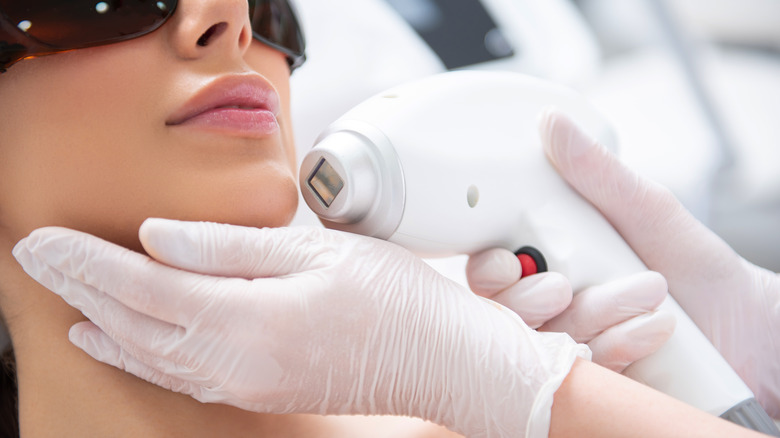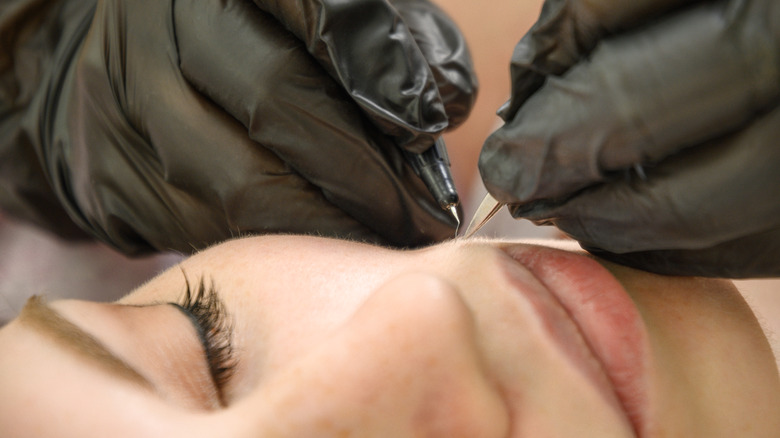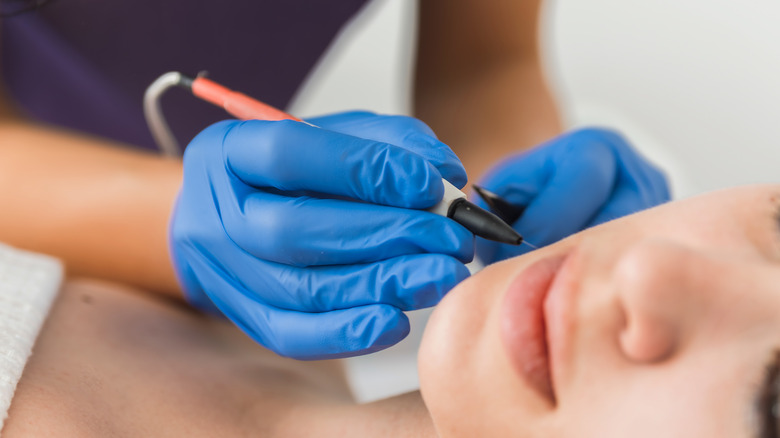What's The Difference Between Laser Hair Removal And Electrolysis?
The phrase "hair removal" can bring to mind unpleasant experiences. Tweezing, shaving, and waxing are some familiar (and often painful) methods that most of us have tried to remove unwanted hair. Then there's the category of hair removers known as chemical depilatories, the deceptively sweet-scented lotions that promise to melt away strands of hair in mere minutes painlessly. The side effects of these techniques can be unpleasant, ranging from razor burn irritation to ingrown hairs. In fact, a study published in The American Journal of Obstetrics and Gynecology found that 60% of women who engaged in pubic hair removal had experienced some form of complication.
While it's true that the methods mentioned above can successfully remove hair, the reality is that they're only short-term solutions that need to be repeatedly implemented to keep its growth at bay. It's not only uncomfortable to endure endless waxing sessions, but it can also prove to be costly over time. For lasting options, two techniques stand out among the rest: laser hair removal and electrolysis. Although they both require a significant investment, they can ease your worries regarding hair regrowth for months, years, or in some cases, forever (via research published in The Journal of the American Academy of Dermatology). You may have heard of laser hair removal or electrolysis in passing, but perhaps you're not entirely sure what distinguishes one from the other. Let's take a closer look at how the two stack up when it comes to epilation.
Understanding laser hair removal
The process of laser hair removal involves the use of light from a laser directed at the hair follicles. Laser hair removal intends to destroy the hair at its root, but the permanence of its effects can vary amongst individuals. For this reason, some experts think that laser hair removal is a misleading name. "[With laser], full removal of all of the hair may not be possible. As the hair becomes thinner and finer, it's more difficult to completely remove it," Dr. Joshua Zeichner explained to Harper's Bazaar.
Still, laser technology is a popular choice for those seeking advanced hair removal techniques. According to consumer healthcare resource RealSelf, laser hair removal costs roughly $850 per session and was deemed "worth it" by 92% of those who had received it. Depending on each individual's situation, the number of sessions required may vary, but multiple treatments are needed to see results. For those with sensitive skin, take note: a significant advantage of laser hair removal is that it doesn't harm delicate skin. "Laser hair removal is successful in decreasing [skin irritation] because it's precise enough to target the hair follicle and eliminate hair at the root without damaging your skin," Dr. Shikhar Saxena, CEO of Milan Laser, told Women's Health.
Risks associated with laser hair removal
There are a few things to consider before booking your appointment for laser hair removal. Although the treatment is known for being more gentle to the skin than other removal methods, it's not entirely painless. Some describe the laser's sensation as like a rubber band being snapped on their skin, but others disagree with this notion. "I found it incredibly painful...[laser technicians] described it as being flicked with a rubber band and boy, was that a lie," Reddit user Its_meme said of their encounter with bikini lasering. Pain tolerance to the removal process can vary, but according to the Mayo Clinic, it's normal to experience mild inflammation or swelling following laser treatment.
A rare complication in those with deeper skin tones can occur, in which hair growth actually increases. "This is most common during facial hair laser treatments in women with Mediterranean, Middle Eastern, and South Asian heritage," Dr. Jamie DeRosa told HuffPost. The types of lasers traditionally used in hair removal procedures have been known to cause irritation or damage to those with darker skin; however, newer technology has developed to circumvent this issue.
The ins and outs of electrolysis treatment
Electrolysis wasn't originally designed to address unsightly hair; instead, it was used to remove hair that got in the way of one's sight. Ophthalmologist Dr. Charles E. Michel was the first to practice electrolysis by utilizing the technique on ingrown eyelashes in 1875 (via the American Council on Science and Health). Dr. Michel's success in treating patients led to the rapid popularization of electrolysis for hair removal.
Electrolysis works by slipping a thin wire, similar to a tiny needle, straight into the hair follicle. The wire is attached to an electrolysis unit, which a practitioner uses to direct energy through the follicle to destroy the hair. According to The American Electrology Association, electrolysis is the only FDA-approved method of permanent hair removal, which separates it from other techniques. Typically, electrolysis professionals charge by the hour, and prices can range from $30 to $100, depending on the length of each session and the area treated.
For many who suffer from PCOS-related hirsutism or excessive unwanted hair, electrolysis is regarded as the best choice for hair removal. "Life-changing doesn't even begin to describe it," stated Redditor Thecurlybuzz upon sharing their progress photos after one year of electrolysis treatments. Furthermore, research published in The PMFA Journal has even demonstrated that electrolysis may be effective at treating cystic acne by targeting overactive sebaceous glands. Unlike laser removal, electrolysis is considered effective and safe for all skin types.
What to know about receiving electrolysis
Hair has four growth phases, and electrolysis is the most effective during the anagen, or growing, stage based on research published in American Family Physician. However, it's difficult to discern which one the hair is in at any given time, and electrolysis needs to be performed on each strand at the correct phase to ensure permanent results. This means electrolysis is a very slow, detail-oriented process that can take months or years, especially when treating large areas of the face or body. For those who commit to long-term treatment schedules, patience pays off. "Your hair will no longer grow and will not come back after you've completed your electrolysis sessions," Dr. Karan Lal affirmed to Cosmopolitan.
Getting electrolysis isn't exactly pain-free, either. "Whew! Electrolysis hurts a lot, but you can't argue with the results," Twitter user @uncooldana wrote of their experience. Because electrolysis uses heat and electric current, there can be an unpleasant feeling when each hair is zapped. Furthermore, according to research published in The Journal of Dermatologic Surgery and Oncology, one way to lessen the pain from electrolysis is to apply a topical anesthetic such as lidocaine cream before treatment.
Following your electrolysis session, you may notice inflammation, discoloration, or raised spots where the follicles were treated. Don't pick at or attempt to lighten these marks as this can lead to scarring. In rare cases, clients treated with electrolysis can develop pitting or keloid scars, often stemming from improper technique (via St. Vincent's Medical Center). You can avoid complications by researching your electrologist and their credentials before obtaining treatment.
Which method of hair removal is right for you?
Laser hair removal and electrolysis are excellent treatment options for hair removal, but they each have specific advantages. Electrolysis is a sure bet if you're someone who experiences exces hair growth or coarse, stubborn hair. By using electrolysis, you'll never need to shave or wax again. If you're not interested in the tediousness of electrolysis sessions for large areas of hair, you may be better suited to laser treatments. Although the results of laser hair removal aren't permanent, the procedure can help reduce overall hair growth and its appearance over time.
Your tolerance to pain can be a deciding factor. Some find electrolysis treatment more painful than laser, but others acclimate to the procedure's sensations. "I got in the habit of napping while my electrologist worked, but no way could I have done that in the first session," Redditor HiddenStill noted of their electrolysis journey. You can work with your provider to develop a treatment plan to suit your pain threshold.
In either case, you'll want to ensure that the practitioner you choose is an experienced professional with proper certifications. The American Academy of Dermatology advises choosing a board-certified dermatologist for laser hair removal procedures. As for electrolysis, the American Electrology Association suggests selecting an electrologist with an AEA membership to ensure they practice true electrolysis for permanent hair removal. Whichever method you choose, it's essential to schedule a consultation to determine whether the provider is the right fit for you.





